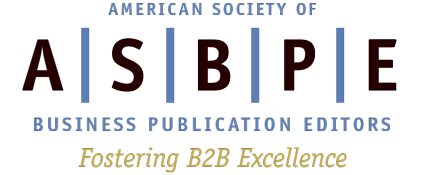By Jeff Gelski
The strategy failed this time. Sarah Redohl typed up information for a law enforcement story. She cut the information into strips of paper and placed the strips on the floor. Previously, such actions had helped her organize and visually align stories.
This time, she had a “million piles” but no connections, no direction.
Undaunted, Redohl, managing editor for the Columbia Business Times in Columbia, Mo., handed a word document containing the information to the magazine’s art director, Kristin Branscom.
“Can you do something with this, please?” Redohl asked.
Award-winning results followed. “The Justice League” appeared in the magazine’s October 2013 issue and helped the Columbia Business Times, a business-to-business publication, win a gold award in visual storytelling in the Central Region of the 2014 Azbee Awards. Another story, which focused on a five-year forecast for the Columbia area, also was noted in the award.
Redohl spoke about the honored work June 18 in an awards ceremony put on by the Kansas City chapter of ASBPE.
Redohl, who has a degree in convergence journalism from the University of Missouri in Columbia, knows the value of visuals. She said research has shown the brain processes images 60,000 times faster than it processes text. She added our brains can dual-code information from pictures, meaning our brains can code it as a picture and as text.
“For example, when you look at a circle, not only do you automatically understand what that is, but you also think in your head, ‘That is a circle,’ “ she said. “So you have text coding for that as well.”
Reader engagement is 44% higher for stories that have a picture than a story with text alone, she said.
“It’s what people crave,” she said of visual elements. “It’s what they’re wanting.”
Redohl and Branscom have worked together for two years. Their visual storytelling routine involves Redohl preparing a word document for Branscom. Redohl types out all the information and denotes in different color type where there should be art, like a pie chart, a map or a person’s photo.
“We know everything about each other,” Redohl said. “We just communicate really well.”
The law enforcement story sought to eliminate confusion in the Columbia area. Agencies seeking to keep the peace include the police department for the University of Missouri, the police department for the city of Columbia and the sheriff’s department for Boone County.
“They all work basically in the same area,” Redohl said.
The story examined such issues as jurisdictions and budgets for each of the three agencies. Visual elements came in the form of the different uniforms, badges, guns and cars for each agency. Here are some examples.
Redohl previously worked for the Travel Channel, NPR and the U.S. Department of State before joining the Columbia Business Times in 2012. In 2013, Folio: selected Redohl as one of 15 under age 30 young professionals driving next-generation innovation.
Redohl also teaches multimedia journalism at the University of Missouri. She oversees college students who work as interns for the Columbia Business Times. Other writers contribute.
Redohl said she personally needs to improve in certain areas. She wants contributing writers to understand how to take of advantage of visual storytelling. She shows them the word documents she hands to Branscom.
“I’ve got find a way to convey these stories to my writers,” she said.
Transitioning stories from the magazine to the web is another area that needs work, she said. The design format may not be appropriate for the web site. Thus, making the story searchable on the web is difficult.
“So I end up having like 300 tags, which is complicated, but it’s necessary if you still want it to be found,” she said. “We’re still looking for a better way.”
Redohl urged editors at the Kansas City awards ceremony to take on difficult tasks.
“The next time you’re challenged with a topic or a story that you think might be impossible, maybe think instead of how it can be possible, and you might just find a really creative solution that will allow you to do really amazing things,” she said.

Jeff Gelski is an associate editor for Sosland Publishing Co. in Kansas City, Mo., where he mainly works for two brands in Food Business News and Milling & Baking News. A member of the Kansas City chapter’s board of directors for the ASBPE, he has worked for business-to-business publications since 1997. After graduating from the University of Missouri’s School of Journalism in 1985, he worked for daily newspapers until 1997.
